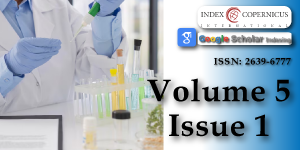Mestranol moieties clicked to Zn(II)phthalocyanine for controllable photosensitized oxidation of cholesterol
Main Article Content
Abstract
Four mestranol moieties were chemically linked to Zn(II) phthalocyanine (4) by cycloaddition “Click” reaction using a tetra-azidoethoxy substituted Zn(II)-phthalocyanine (3). The alkyl-azido coupling reaction was realized between azido groups of 3 and alkyl group of mestranol. The alkylation reaction was carried out to obtain cationic Zn(II) phthalocyanine derivative (5). The new compounds were chemically characterized by the known analytical methods. The absorption and fluorescence properties were studied in comparison. The absorption maxima of phthalocyanines 3, 4 and 5 were recorded at approx. shifts of 8 - 12 nm in the far- red region (680 - 684 nm) and the fluorescence maxima (692 - 693 nm) as compared to unsubstituted ZnPc (672 nm, 680 nm) in DMSO. The studies of singlet oxygen generation of 3, 4 and 5 showed relatively high values such as 0.52 for 3; 0.51 for 4 and 0.46 for 5. The fluorescence lifetime of 3.15 ns (3), 3.25 ns (4) and 3.46 ns (5) were determined with lower than the value than for the used standard ZnPc (3.99 ns). The high photo stability was observed for compounds 3, 4 and 5. In addition, the photosensitized oxidation of cholesterol was compared for 3 and 4 with much lower values of oxidation potential than for unsubstituted ZnPc which suggests that the substitution groups influenced on the photooxidation index of the target molecule.
Article Details
Copyright (c) 2021 Mantareva V, et al.

This work is licensed under a Creative Commons Attribution 4.0 International License.
Ben-Hur E, Green M, Prager A, Kol R, Rosenthal I. Phthalocyanine photosensitization of mammalian cells: biochemical and ultrastructural effects. Photochem Photobiol. 1987; 46: 651-656.
Galstyan A. Turning photons into drugs: phthalocyanine-based photosensitizers as efficient photoantimicrobials. Chemistry. 2021; 27: 1903-1920. PubMed: https://pubmed.ncbi.nlm.nih.gov/32677718/
Nakonieczna J, Wozniak A, Pieranski M, Rapacka-Zdonczyk A, Ogonowska P, et al. Photoinactivation of ESKAPE pathogens: overview of novel therapeutic strategy. Future Med Chem. 2019; 11: 443-461. PubMed: https://pubmed.ncbi.nlm.nih.gov/30901231/
MacDonald IJ, Dougherty TJ. Basic principles of photodynamic therapy. J Porphyrins Phthalocyanines. 2001; 5: 105-129.
Bacellar IOL, Tsubone TM, Pavani C, Baptista MC. Photodynamic Efficacy: From Molecular Photochemistry to Cell Death. Int J Mol Sci. 2015; 16: 20523-20559. PubMed: https://pubmed.ncbi.nlm.nih.gov/26334268/
Bin ZS, Awlad HM, Rachel N, Varshil M, Taib MK, et al. A review on antibiotic resistance: alarm bells are ringing. Cureus. 2017; 6: 1403. PubMed: https://pubmed.ncbi.nlm.nih.gov/28852600/
Paronyan MH, Koloyan HO, Avetisyan SV, Aganyants HA, Hovsepyan AS. Study of the possible development of bacterial resistance to photodynamic inactivation. Biolog J Armenia. 2019; 1: 17-22.
Li X, Zheng BD, Peng XH, Li SZ, Ying JW, et al. Phthalocyanines as medicinal photosensitizers: Developments in the last five years. Coord Chem Rev. 2017; 379: 147-160.
Albuquerque HMT, Santos CMM, Silva AMS. Cholesterol-Based Compounds: Recent Advances in Synthesis and Applications. Molecules. 2019; 24: 116. PubMed: https://www.ncbi.nlm.nih.gov/pmc/articles/PMC6337470/
El-Akra N, Noirot A, Faye JC, Souchard JP. Synthesis of estradiol-pheophorbide a conjugates: evidence of nuclear targeting, DNA damage and photodynamic activity in human breast cancer and vascular endothelial cells. Photochem Photobiol Sci. 2006; 5: 996-999. PubMed: https://pubmed.ncbi.nlm.nih.gov/17077894/
Girotti AW, Korytowski W. Cholesterol Peroxidation as a Special Type of Lipid Oxidation in Photodynamic Systems. Photochem. Photobiol. 2019; 95: 73-82. PubMed: https://pubmed.ncbi.nlm.nih.gov/29962109/
Khan EH, Ali H, Tian H, Rousseau J, Tessier G, et al. Synthesis and Biological Activities of Phthalocyanine-Estradiol Conjugates. Bioorg Med Chem Lett. 2003; 13: 1287-1290. PubMed: https://pubmed.ncbi.nlm.nih.gov/12657265/
Segalla A, Milanesi C, Jori G, Capraro HG, Isele U, et al. CGP 55398, a liposomal Ge(IV) phthalocyanine bearing two axially ligated cholesterol moieties: a new potential agent for photodynamic therapy of tumors. Br J Cancer. 1994; 69: 817-825. PubMed: https://pubmed.ncbi.nlm.nih.gov/8180009/
Orekhov PS, Kholina EG, Bozdaganyan ME, Nesterenko AM, Kovalenko IB, et al. Molecular mechanism of Uptake of Cationic Photoantimicrobial Phthalocyanine across Bacterial Membranes Revealed by Molecular Dynamic Simulations. J Phys Chem. 2018; 122: 3711-3722. PubMed: https://pubmed.ncbi.nlm.nih.gov/29553736/
Girotti AW, Korytowski W. Cholesterol as a Singlet Oxygen Detector in Biological Systems, In: Methods in Enzymology, Academic Press. 2000; 319: 85-100. PubMed: https://pubmed.ncbi.nlm.nih.gov/10907502/
Zorlu Y, Un I, Hirel C, Dumoulin F, Ahsen V. Phthalonitriles Functionalized for Click Chemistry. Design, synthesis and Structural Characterization. J Chem Crystallogr. 2013; 43: 636-645.
George RD, Snow AW. J Heterocyclic Chem. 1995; 32: 495-498.
Novakova V, Zimcik P, Miletin M, Kopecky K, Ivincova J. A phthalocyanine-mestranol conjugate for photodynamic therapy prepared via click chemistry. Tetrahedron Lett. 2010; 51: 1016-1018.
Jia X, Yang FF, Li J, Liu JY, Xue JP. Synthesis and in Vitro Photodynamic Activity of Oligomeric Ethylene Glycol–Quinoline Substituted Zinc(II) Phthalocyanine Derivatives. J Med Chem. 2013; 56: 5797-5805. PubMed: https://pubmed.ncbi.nlm.nih.gov/23786380/
Cakir V, Goksel M, Durmuş M, Biyiklioglu Z. Synthesis and photophysicochemical properties of novel water soluble phthalocyanines. Dyes Pigm. 2016; 125: 414-425.
Ekineker G, Goksel M. Synthesis of both peripheral and non-peripheral substituted metal-free phthalocyanines and characterization. Tetrahedron. 2020; 76: 130878.
Nishie H, Kataoka H, Yano S, Kikuchi JI, Hayashi N, et al. A next-generation bifunctional photosensitizer with improved water-solubility for photodynamic therapy and diagnosis. Oncotarget. 2016; 7: 74259-74268. PubMed: https://pubmed.ncbi.nlm.nih.gov/27708235/
Simpson CA, Huffman BJ, Gerdon AE, Cliffel DE. Unexpected Toxicity of Monolayer Protected Gold Clusters Eliminated by PEG-Thiol Place Exchange Reactions. Chem Res Toxicol. 2010; 23: 1608-1616. PubMed: https://pubmed.ncbi.nlm.nih.gov/20715858/
Girotti AW. Photosensitized oxidation of membrane lipids: reaction pathway, cytotoxic effects, and cytoprotective mechanisms. J Photochem Photobiol B Biol. 2001; 63: 103-113. PubMed: https://pubmed.ncbi.nlm.nih.gov/11684457/
Jia HR, Zhu YX, Chen Z, Wu FG. Cholesterol-Assisted Bacterial Cell Surface Engineering for Photodynamic Inactivation of Gram-Positive and Gram-Negative Bacteria. ACS Appl. Mater Interfaces. 201; 9: 15943-15951. PubMed: https://pubmed.ncbi.nlm.nih.gov/28426936/
Mosinger J, Mosinger B. Photodynamic sensitizers assay: rapid and sensitive iodometric measurement, Experientia. 1995; 51: 106-109. PubMed: https://pubmed.ncbi.nlm.nih.gov/7875246/

